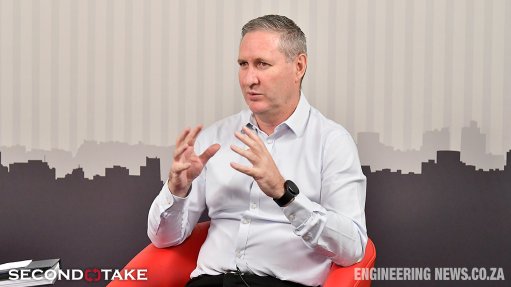No timeframe yet for the development of green hydrogen corridor – Toyota SA
There is no time or cost framework yet for the proposed pilot project by Sasol and Toyota South Africa Motors (TSAM) to develop a green hydrogen mobility corridor, says the local arm of the Japanese carmaker.
“We have just started this exploration, hence no time and cost information may be made available at this juncture.
“We will be able to communicate the timeframes, in due course, as the project progresses further into the future.”
TSAM, responding to questions from Engineering News & Mining Weekly, says the initial focus is to study how it may introduce hydrogen technology into South Africa, “but this will be guided by our principal in Japan”.
Toyota announced last year that it had developed a second-generation hydrogen fuel cell system to power heavy-duty trucks.
It is based on the fuel cell system the carmaker launched in the new-generation, 2021 Mirai hydrogen fuel cell electric sedan.
Under the current testing regime, the second-generation fuel cell system delivers more than 480 km of range on a truck with a load weight of 36 t.
Sasol and TSAM earlier this month formally announced the formation of the partnership to jointly pursue the development of a proof-of-concept demonstration for a green hydrogen mobility ecosystem.
The partnership is partly based on Sasol’s experience in the production, use and marketing of grey hydrogen, as well as its aspiration to play a leading role in the establishment of a green hydrogen economy for South Africa.
Grey hydrogen is produced using fossil fuels, whereas green hydrogen is produced using renewable energy.
The parties said they intended to develop a mobility corridor and expand this demonstration to a pilot project using one of South Africa’s main freight corridors, such as the N3 route between Durban and Johannesburg, for hydrogen-powered heavy-duty long-haul trucks.
This process includes the possible installation of a hydrogen refuelling station.
To enable the project, the parties would also have to pursue the introduction of a fuel cell truck into South Africa.
Current research shows that long-distance mobility is better suited to fuel cell technology than battery electric trucks, which operate better over shorter distances.
The only problem is that there are currently no Toyota fuel cell trucks available to introduce into South Africa, as they are still in prototype development in Japan.
TSAM says it has, however, started investigating the introduction of a fuel cell truck into South Africa as soon as it becomes available from its principal in Japan.
While TSAM will lead the investigation into the introduction of a fuel cell truck, Sasol will look at providing the required infrastructure expertise.
“We are excited about the partnership with Sasol, which we hope will assist in scaling up investment in critical infrastructure, such as charging stations and the fuel itself,” said TSAM president and CEO Andrew Kirby.
The TSAM-Sasol project may, however, require the expansion of the partnership to include other companies and stakeholders along the hydrogen mobility value chain.
This is to allow local industry to gain valuable first-hand knowledge of hydrogen refuelling stations, the introduction of hydrogen into heavy-duty truck supply chains and the commercial drivers underpinning the hydrogen mobility value chain.
“To unlock green hydrogen opportunities, we are pursuing various demonstration opportunities and partnerships, as with Toyota, with the intent of enabling and taking advantage of technology developments and breakthroughs,” noted Sasol president and CEO Fleetwood Grobler earlier this month.
“One of the focus areas for Sasol in South Africa is to provide a comprehensive and sustainable mobility solution. Hydrogen and electric vehicles with refuelling and charging infrastructure form part of this sustainable future.
“We believe hydrogen mobility is a real opportunity for the country to decarbonise the sectors of long-haul and heavy-duty transport, mining and others, and see the creation of hydrogen hubs, or ecosystems, as a practical and affordable way to scale the deployment of hydrogen in the transport sector.
“Our partnership with Toyota, which will include other partners over time, aims to build sustainable end-to-end infrastructure for hydrogen mobility, initially focused on piloting the concept.”
Kirby echoed this sentiment, noting that Toyota envisaged this partnership to also create the environment for others to get involved in the hydrogen mobility value chain, “thereby making sustainable contributions to the South African economy”.
Hydrogen Potential
At the launch of the new-generation Mirai last year, Toyota CTO Masahiko Maeda said that sales were not the automotive company’s immediate focus.
“Instead, Toyota has a larger target of contributing to the realisation of a carbon-neutral society.
“Toyota would like to make it easier for as many people as possible to use hydrogen in their daily lives. The potential of hydrogen to help achieve a future zero-emission society is generating fast-growing interest and investment globally.”
Grobler noted earlier this month that South Africa was endowed with exceptional renewable-energy resources, making the country ideal for green hydrogen production, which had the potential to contribute to energy security and trade for South Africa, while facilitating the transition to a lower-carbon economy.
“The new hydrogen economy will be enabled by co-creating hydrogen ecosystems developed through partnerships. The creation of value chain partnerships will be critical to enable South Africa to be globally competitive in the green hydrogen markets.
Comments
Announcements
What's On
Subscribe to improve your user experience...
Option 1 (equivalent of R125 a month):
Receive a weekly copy of Creamer Media's Engineering News & Mining Weekly magazine
(print copy for those in South Africa and e-magazine for those outside of South Africa)
Receive daily email newsletters
Access to full search results
Access archive of magazine back copies
Access to Projects in Progress
Access to ONE Research Report of your choice in PDF format
Option 2 (equivalent of R375 a month):
All benefits from Option 1
PLUS
Access to Creamer Media's Research Channel Africa for ALL Research Reports, in PDF format, on various industrial and mining sectors
including Electricity; Water; Energy Transition; Hydrogen; Roads, Rail and Ports; Coal; Gold; Platinum; Battery Metals; etc.
Already a subscriber?
Forgotten your password?
Receive weekly copy of Creamer Media's Engineering News & Mining Weekly magazine (print copy for those in South Africa and e-magazine for those outside of South Africa)
➕
Recieve daily email newsletters
➕
Access to full search results
➕
Access archive of magazine back copies
➕
Access to Projects in Progress
➕
Access to ONE Research Report of your choice in PDF format
RESEARCH CHANNEL AFRICA
R4500 (equivalent of R375 a month)
SUBSCRIBEAll benefits from Option 1
➕
Access to Creamer Media's Research Channel Africa for ALL Research Reports on various industrial and mining sectors, in PDF format, including on:
Electricity
➕
Water
➕
Energy Transition
➕
Hydrogen
➕
Roads, Rail and Ports
➕
Coal
➕
Gold
➕
Platinum
➕
Battery Metals
➕
etc.
Receive all benefits from Option 1 or Option 2 delivered to numerous people at your company
➕
Multiple User names and Passwords for simultaneous log-ins
➕
Intranet integration access to all in your organisation
















